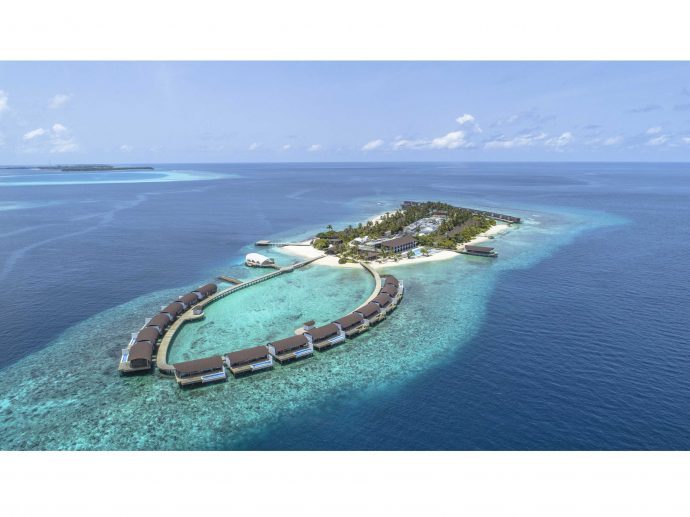Categories more
- Adventures (17)
- Arts / Collectables (15)
- Automotive (37)
- Aviation (11)
- Bath, Body, & Health (77)
- Children (6)
- Cigars / Spirits (32)
- Cuisine (16)
- Design/Architecture (22)
- Electronics (13)
- Entertainment (4)
- Event Planning (5)
- Fashion (46)
- Finance (9)
- Gifts / Misc (6)
- Home Decor (45)
- Jewelry (41)
- Pets (3)
- Philanthropy (1)
- Real Estate (16)
- Services (23)
- Sports / Golf (14)
- Vacation / Travel (60)
- Watches / Pens (15)
- Wines / Vines (24)
- Yachting / Boating (17)
Published
10/10/2020 by Westin Hotel & ResortsOn Miriandhoo, a coral island in the Baa atoll, surrounded by the Indian Ocean, whose variety of marine life earned it the status of UNESCO Biosphere Reserve in 2011, is the Westin Maldives Miriandhoo Resort.
Designed by the Peia Associati architecture firm in Milan for Westin, a Marriott International Group operator, and inaugurated in October 2018, the luxury resort comprises 70 hospitality units composed of suites and private villas with swimming pools and ocean views, 41 of them on the island and 29 in the water, as well as 9 public buildings dedicated to providing services for guests and 16 buildings for staff.
The main aim of the project was to take great care to preserve a delicate environmental setting and to preserve the balance of nature by reducing consumption of the soil and its resources to a minimum.
Particular attention has been paid to the materials used, regarding both the choice of the timber used for the roofs of the bungalows, the pier and for the jetties of the units built on the piles sourced from controlled rapid reforestation areas, and the choices made for the interiors of the hospitality facilities, using natural materials obtained by mixing lime-based plasters with pieces of wood and dead coral.
Alongside the natural materials, Casalgrande Padana porcelain stoneware tiles from the Antique Wood, Architecture, Marmoker and Marte collections were chosen for the floors and coverings. Made exclusively from natural raw materials, free from glazes, plastic and harmful substances, they are an eco-sustainable, long-lasting, innovative material, particularly suitable for use in a low-environmental-impact project.
The Project
Peia Associati adopted a ‘holistic’ approach, and to this end, worked closely with Professor Sahig, an environmental expert, in order to study techniques able to combat coastal erosion, find solutions to effectively harness wind power and reduce energy consumption, all in harmony with the natural elements that make up the island: from the lush green, leafy vegetation to the marine life in the waters around the coral island.
Cubes of waterproof concrete are topped with a double wooden roof with a shell-like shape, which, by creating a natural ventilation system, makes it possible to absorb heat, while the use of the reinforced concrete has a cooling function that allows for a significant reduction in energy consumption.
These curved roofs are accompanied by the flat roofs of a number of structures placed in the middle of the island, which become the ideal support for positioning solar and photovoltaic panels, as well as offering useful support for the hydroponic methods used to grow fruit and vegetables on the island, boosting the Resort's self-sufficiency in terms of food supplies.
An attractive wooden jetty links the luxury pile-dwellings that stretch out into the sea, creating a sort of large natural swimming pool, while on the other side of the island, the structure is closed off with another series of pile-dwellings that appear to draw a curved line on the water.
The use of porcelain stoneware tiles
The floors of the reception and spa areas have been covered with wood-effect Casalgrande Padana ceramic tiles from the Antique Wood collection, in the colour white and the 15x120 cm format, while the restaurant area has been tiled using Grigio Maggia marble-effect stoneware from the Marte collection, in the large 60x120 cm format, with a natural finish for the interiors and an anti-slip, bush-hammered finish for the outside areas.
For the floors of the bedrooms in the suites, and for the inside of the swimming pools, the white Thassos tiles from the Marte collection were used.
Particular attention was paid to the choice of the coverings in the open-plan bathrooms, in which ceramic tiles have been used on both the floors and walls, to create a sensation of visual continuity between the interior and the outdoor part of the bathroom-garden.
The inside of the shower has been tiled with the Statuario Grigio colour from the Marmoker collection, specifically created in a mirror version and installed using the open-vein technique.
An architectural structure nestling amid sand, coral and the myriad of nuances that colour the sea, in a corner of the world lost in a timeless dimension, between the silence and the powerful, vital energy of nature, offering an example of how to build and to operate in environmental settings with a delicate, fragile balance.















